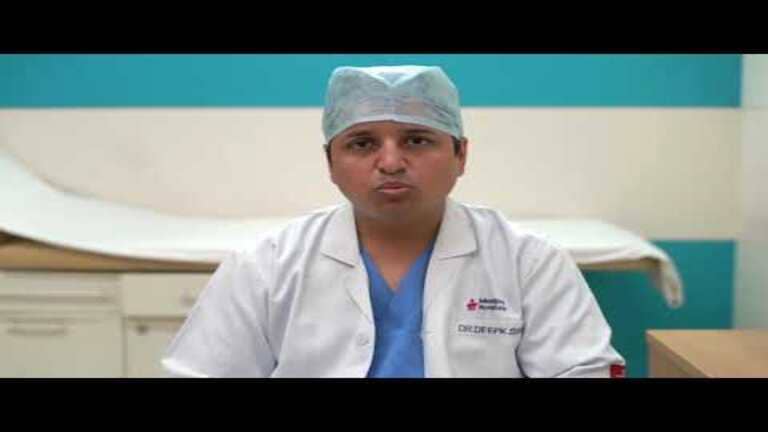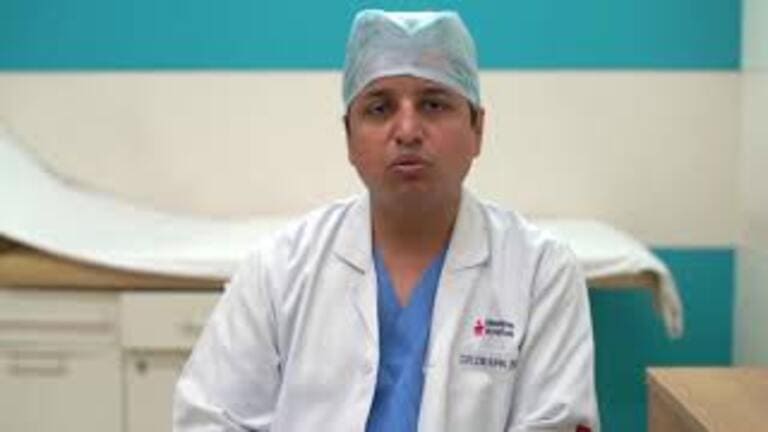

Cancer Care
Cancer Hospital in Jaipur
Cancer is a disease characterized by abnormal cells that divide uncontrollably and have the ability to invade other tissues. There are many types of cancer including skin, breast, prostate, lung, colon, and leukemia. Genetic changes (including inherited mutations), environmental factors (such as radiation or carcinogens), and lifestyle choices (such as smoking) may cause cancer. Early detection is key to successful treatment. Some cancers in India are more common than others: Breast cancer is the most common among women and lung cancer is among men. Cancer cases in India have increased significantly over time due to a lack of awareness about prevention measures and late diagnosis due to a poor understanding of symptoms. Oncology is the study of cancer. It's a medical field that focuses on treating and preventing cancer by looking at its causes, symptoms, and treatment options. Oncologists specialize in treating cancer patients.

OUR STORY
Know About Us
Why Manipal?
At Manipal Hospitals, Jaipur, we treat each patient as an individual to provide the best possible treatment for their particular cancer. Our Tumour Board discussions are a chance for all of our doctors to meet and discuss every patient's case so that we can give them the best possible care. Visit Manipal Hospitals, the cancer hospital in Jaipur for treatment.
Our evidence-based chemotherapy guidelines follow international standards for treating various solid and haematological cancers.
Treatment & Procedures
A core biopsy is a procedure where a needle is passed through the skin to obtain a sample of tissue from a mass or lump. The tissue sample is then examined under a microscope for any abnormalities.
Chemotherapy has been the accepted therapeutic paradigm for the treatment of advanced cancers. This mode of treatment involves the use of systemic chemotherapy drugs which target specific areas where cancer cells grow.
Colposcopy is a diagnostic procedure in which a colposcope (a dissecting microscope with various magnification lenses) is used to provide an illuminated magnified view of the cervix, vagina, vulva or anus to identify precancerous and cancerous lesions so that they may be treated early.
This therapy of cancer treatment uses the body's immune system to kill cancer cells. Biological therapy for cancer is used in the treatment of many types of cancer to prevent or slow tumor growth and to prevent the spread of cancer.
Intracavitary chemotherapy involves the injecting of chemotherapy through a tube (catheter), directly into a body cavity. It gives a very high dose of chemotherapy to the tumour, but only a very low dose to the rest of the body. Intracavitary chemotherapy can be injected into the bladder – intravesical, the abdominal cavity – intra peritoneal, or the…
Day care chemotherapy is extended to those patients who have been advised short therapies or cancer procedures that do not require a night stay in hospital. Domiciliary chemotherapy involves making chemotherapy services available to cancer patients in their homes. This is mostly for the elderly who cannot reach the hospital for chemotherapy sessions.
Bone marrow transplant is a procedure where a person's faulty bone marrow stem cells are replaced by healthy ones. Bone marrow transplants are done to treat patients suffering from leukemia, and severe blood diseases such as thalassemias, aplastic anemia, and sickle cell anemia, as well as multiple myeloma and certain immune deficiency diseases.
A PICC is a thin, flexible tube that is inserted into a vein in the upper arm and guided into a large vein above the right side of the heart called the superior vena cava. It is used to give intravenous fluids, blood transfusions, chemotherapy, and other drugs. Bone marrow aspiration is the removal of a small amount of this tissue in liquid form for…
In order to reach inaccessible tumours, shorten surgery time or to reduce side effects, onco surgeons prescribe the innovative robotic surgery.
In some cancer patients, chemotherapy is safely delivered through a standard (or “peripheral”) IV line. Other times, infusions must be administered through a central line catheter, such as a PICC, CVC or port.
Palliative care is the holistic approach to cancer care that addresses the patient as a whole, not just their disease. It also means learning to manage the cancer symptoms and side effects.
Child life specialists focus on the optimal development and well-being of infants, children, adolescents, and young adults suffering from cancer. They help in promoting coping skills and minimizing the adverse effects of hospitalization, health care, and other potentially stressful experiences.
Play is a natural part of childhood and is important in child development. Through play therapy children also learn self-control, self respect, to express their feelings, problem solving, communication skills, and to modify problem behaviors. In children afflicted with cancer, play therapy is a comforting tool.
Counseling is an integral element of oncology treatment. A counselor is trained to listen to the patient and the physical, mental, emotional and spiritual problems that he or she might face
SBRT is also known as stereotactic ablative radiotherapy. This machine administers very high doses of radiation, using several beams of various intensities aimed at different angles to precisely target the tumor.
SRS refers to the precise and focused delivery of a single, high dose of radiation in a single session and has been used to treat various intracranial and skull base lesions.
This is the latest non-invasive, non-melanoma skin cancer treatment option through delivering a precise and calibrated dose of radiation that penetrates just below the skin's surface, only a mere 5 millimeters. It safely and effectively destroys malignant non-melanoma skin cancer cells.
3D-CRT, involves creating 3-D computer images and delivering highly focused radiation to tumors while sparing nearby healthy tissue. 3D-CRT is a type of external beam radiation therapy (EBRT), which is the most common radiation treatment used for cancer of the inner lining of the chest or lungs.
Palliative radiation therapy is one form of palliative therapy which treats the symptoms of the cancer. The radiation is used to shrink a tumor or tumors that are causing the symptoms.
For tumors in the thorax and abdomen, reducing the treatment margin for organ motion due to breathing reduces the volume of normal tissues that will be irradiated. ABC apparatus is constructed consisting of 2 pairs of flow monitor and scissor valve, 1 each to control the inspiration and expiration paths to the patient. The patient breathes through…
The smart arc machine is designed to provide the tools to create rotational intensity-modulated radiation therapy (IMRT) plans using a conventional linear accelerator and a conventional multileaf collimator (MLC). Plans are delivered while the gantry rotates around the patient. The intensity of the radiation is modulated and the shape of the beam is…
Brachytherapy involves placing radioactive material inside your body. Brachytherapy is one type of radiation therapy that's used to treat cancer and is sometimes called internal radiation. Brachyvision is a complete 3D treatment planning system that introduces a new paradigm of patient-centric, image-based planning.
Two Linear accelerator – Elekta Precise and Elekta Infinity along with Gamma med brachytherapy system offering complete range of radiation oncology service. Manipal Hospital sports the highly advanced brachytherapy system using precision radiation medicine to work towards a future where all patients can benefit from precise and individually tailored…
IGRT is one of the most advanced innovations in cancer technology available. It uses advanced 2D and 3D imaging to ensure that the positioning of the tumor will match the dose delivery on this state of the art machine. Since tumors can move during treatment because of the patient’s breathing, IGRT allows doctors to locate and track the tumor during…
IMRT is an advanced mode of high-precision radiotherapy that uses computer-controlled linear accelerators to deliver precise radiation doses to a malignant tumor or specific areas within the tumor.
The VMAT is a unique radiation therapy technique that delivers the radiation dose continuously as the machine rotates.
Why choose Manipal
Brachytherapy treatment involves placing radioactive sources such as a catheter, needle or applicator into a device called an interstitial implant. This device is then inserted into the vagina, uterus or body tissues. The interstitial implant is surgically placed into your pelvis first.
The ICR is a type of internal radiation therapy in which radioactive material sealed in needles, seeds, wires, or catheters is placed directly into a body cavity such as the chest cavity or the vagina. Radiation therapy uses high energy x-rays or radioactive particles to kill cancer cells and may be used for cervical cancer treatment.
IGB uses advanced imaging techniques to make brachytherapy more precise, safe, and effective. Brachytherapy is done through four phases that include the placement of hollow catheters or hollow carriers, CT or MRI imaging of the site, computer calculations of the dose distribution, and robotic radiation treatment.
This expansive discipline includes:
- SLNB – Sentinal Lymph Node Biopsy
- MIRP – Minimal Invasive Radio-guided Parathyroid Surgery
- ROLL – Radio-guided Occult Lesion Localisation for CA breast(early breast cancer)
In women who have undergone breast surgery which involved mastectomy or the removal of the breast, breast reconstruction is the best option. Breast reconstruction is to reform or reshape one or both breasts after a mastectomy, or even lumpectomy where the affected portion of the breast is cut away.
The mammogram or an X-ray of the breast is the most effective screening tool for breast cancer. It can detect breast cancer up to two years before the tumor can be felt by you or your doctor. Women aged 40 - 45 or older, or those at average risk of breast cancer should undergo a mammogram annually.
Oncoplastic surgery is a technique that improves cosmetic outcomes in breast cancer patients. Onco plastic surgeons combine breast cancer tumor removal (a lumpectomy or partial mastectomy) and plastic surgery techniques (reconstructive surgery) at the same time of breast conservation surgery.
This involves removing the tumor and some normal tissue around it but not the breast itself. Some lymph nodes under the arm may be removed as well as a part of the chest wall lining if the tumor is near it.
Voice Prosthesis Surgery for CA Larynx A voice prosthesis is the most common way to restore speech after a total laryngectomy surgery to remove your whole voice box. This is usually the result of laryngeal cancer when cancer starts in the voice box (larynx). It is a rare type of head and neck cancer. Tracheo oesophageal puncture (TEP) is the most common…
Musculoskeletal oncology specialists treat bone and soft tissue tumors including other musculoskeletal system issues in adults and children. These include the efficient treatment of bone cancer, bone metastases, osteomyelitis, and multipla myeloma.
In complex head and neck cancers, patients tend to lose parts of their facial features to cancerous growth. Micro vascular reconstruction of the face and neck region is the only solution. This highly advanced surgical technique to rebuild the face and neck uses the blood vessels, bone, tissue, as well as muscle and skin from other parts of the body.…
The extremely efficient and effective robotic surgery is known for its efficacy and precision in treating gynaecological cancer cases of all types. This technique is also adopted to perform hysterectomies for uterine fibroids, myomectomies for fibroids, and resections for endometriosis.
Proven worldwide, a multidisciplinary approach involving a team of multi-specialists is the standard of care for all cancers. The multidisciplinary Tumour Board at Manipal Hospital provides a forum for cancer specialists to present their cases and discuss the complex nature of the cases with their colleagues across all cancer specialties. This team…
For both gastro-intestinal and digestive diseases, minimally invasive robotic surgery has been the benchmark of treatment procedures. Our multidisplinary team of gastro intestinal surgical oncologists and colorectal surgeons are of high calibre in the domain of treatment.

What is Cancer?
Cancer is a disease in which abnormal cells divide uncontrollably and spread to other parts of the body. There are two main types of cancer: malignant (cancerous) and benign (non-cancerous). In healthy people, cells grow and die at a relatively constant rate. If there is too much cell growth or not enough cell death, it can lead to the formation of a tumour. When a tumour metastasis (has spread to another part of the body), it becomes malignant.
Benign tumours are localised and do not spread, while cancerous tumours can spread via the bloodstream or lymphatic system.
Manipal Hospitals has the best cancer specialist in Jaipur along with the availability of other experts in allied specialities such as cardiology, and neurology under a single roof. This helps us provide comprehensive care to patients in complicated scenarios. We have helped patients with many cancer treatments:
-
Breast Cancer
-
Lung Cancer
-
Oral Cancer
-
Gastrointestinal Cancer
-
Hepatobiliary Cancers
-
Gynecological Cancer
-
Head and Neck Cancers
-
Urogenital Cancer
-
Bone and Soft-tissue Cancer
-
Thoracic Cancer
-
Pediatric Cancer
-
Hematolymphoid Cancer
Diagnosis Facilities
- Core Biopsy
A core biopsy is a medical procedure in which a tissue sample from the body goes for investigation. A hollow needle into the patient's body takes the sample or a device that uses suction to pull out the tissue and then cuts it into sections for analysis.
Core biopsies determine whether there are abnormal cells in tissues and organs and whether they may be cancerous. Core biopsies can also help doctors determine if there is inflammation or infection in a specific area of the body.
- Colposcopy
A colposcopy uses a magnifying device to examine the cervix, vagina, and vulva for abnormalities. It diagnoses cervical cancer and pre-cancerous conditions of the cervix, including human papillomavirus (HPV) infection (genital warts).
The doctor opens the vagina using a speculum and applies acetic acid or iodine to the cervix to make abnormal areas more visible. The doctor then uses a colposcope—a special microscope—to look at these areas more closely.
- Mammogram
A mammogram is a breast X-ray that can help detect breast cancer.
During a mammogram, the patient lies down on an X-ray table, and the technologist takes the X-rays from several different angles. The technologist may ask her to breathe normally or hold her breath for a brief period during the procedure.
Afterwards, the technologist may apply pressure with gauze pads to help remove any fluid from between layers of skin.
Visit the Best Cancer Hospital in Jaipur to get the finest cancer care treatment with the top cancer care doctors in Jaipur.
Treatment Facilities
- Immunotherapy
Immunotherapy is a form of cancer treatment that aims to harness the immune system's power to fight off cancer cells. It does this by training the body's T-cells to recognise and attack malignant cells and introducing new immune cells that can target cancer cells directly.
It is one of the most promising treatments for cancers like melanoma, lung cancer, bladder cancer, and kidney cancer.
- Chemotherapy
Chemotherapy uses drugs to kill cancer cells. Chemotherapy drugs are cytotoxic agents as they destroy cells. The word "chemotherapy" literally means "to use chemicals to treat disease."
Chemotherapy treats cancer in different ways- before surgery or radiation therapy, or after surgery and radiation therapy- to reduce the chance that cancer will come back (recur). Chemotherapy also helps if someone has a particular type of cancer that has not gotten better after trying other treatments.
- Intra Cavitary Chemotherapy
Intra Cavitary Chemotherapy uses drugs that are injected directly into the body cavity. The most common form of this treatment is intraperitoneal chemotherapy, which treats cancer that has spread to the abdominal cavity.
Intra-cavity chemotherapy can be used as a single treatment or combined with other treatments such as radiation therapy or surgery.
- Targeted Therapy
Targeted cancer therapy is a way of treating cancer that uses drugs, antibodies, or other substances to kill a specific type of cancer cell. It targets the particular mutation that causes cancer, such as a genetic defect or chromosomal abnormality. Visit our top multispecialty hospital in Jaipur for treatment.
Targeted cancer therapy can treat alone or in combination with other treatments.
- Biological Therapy
Biological cancer therapy is a treatment that uses the body's natural immune system to destroy cancer cells. Biological therapy helps patients with solid tumours and blood cancers, such as leukaemia and lymphoma.
Biological cancer therapy works by introducing new treatments into the patient's body that help the immune system recognise and destroy tumour cells. Vaccines, antibodies, and gene therapies are common forms of Biological therapy.
- Bone Marrow Transplant
A bone marrow transplant uses stem cells to replace damaged or diseased bone marrow. Bone marrow is the spongy tissue inside bones that produces blood cells.
Bone marrow transplants treat certain cancers and blood disorders. They can be autologous, in which your own donated stem cells are used, or allogeneic, in which you receive donor stem cells from another person.
The procedure uses a high dose of chemotherapy or radiation therapy to kill off diseased or damaged cells in your body. Then, healthy stem cells from a donor's umbilical cord blood, peripheral blood (blood taken from veins), or bone marrow go into your bloodstream through an IV. The healthy stem cells travel through your body and begin to produce new healthy blood cells in your bone marrow.
PICC, Bone Marrow Aspiration And Biopsy. A peripherally inserted central catheter is a pipe inserted into a vein in the arm or hand. It gives medicine and fluids or takes blood samples. A PICC is one of the most popular ways to provide intravenous (IV) medication or fluids. It is also called a "tunnelled catheter."
A PICC can stay for weeks, allowing you to avoid repeated trips to the hospital or clinic for treatment. The PICC line is also a port for chemotherapy treatments and blood transfusions. After removal of the PICC line, bone marrow aspiration extracts a minuscule amount of this tissue for examination.
- Robotic Assisted Surgery
Robotic-assisted surgery is a form of surgery that utilises a robot to assist in the removal of cancerous tissue. The robot is programmed to move in exact ways and perform tasks that would otherwise be impossible for humans to do. Robotic-assisted surgery allows surgeons to operate with greater precision than ever before, which may lead to better patient outcomes.
- Central Line and Chemo Port
A central line catheter is a long, flexible tube inserted into a vein in the neck, chest or groin area and threaded to the heart. The catheter injects fluids, blood, and medicine directly into the heart muscle and administers chemotherapy, blood transfusions and other medication. It can also monitor blood pressure and oxygen levels.
A chemo port is a small catheter put under the skin, usually in the chest area, to provide a direct line for chemotherapy. The port allows continuous access to the bloodstream so that chemotherapy can be given continuously for four weeks. Visit Manipal Hospitals and consult with the doctors.
- Palliative Care
Palliative cancer care is a way of treating cancer that focuses on improving a patient's quality of life rather than simply extending their life. The goal is to improve the patient's well-being by helping them manage their symptoms and side effects, including pain and fatigue while supporting family members.
It's important to note that palliative care isn't just for those dying: it can help at any stage of the disease.
- Child Life Care
Child Life Cancer Care is a program that helps children and young adults who are dealing with cancer or have recently completed treatment. It aims to help them cope with their illness, interact with other kids going through the same thing, and have fun.
- Play Therapy Care
Play therapy uses child's play to help them process emotional and behavioural issues. The therapist will use play materials, toys, or games to help the child express their feelings, gain insight into their problems, or learn new behaviours.
Play therapy care is a particular therapy that uses play materials and games to help children cope with the stress and anxiety caused by cancer and its treatment.
- Counselling
Cancer counselling is a service that provides emotional support for patients and their families. Cancer counsellors help patients deal with the stress and anxiety associated with a cancer diagnosis and help them cope with treatment side effects.
Cancer counselling can benefit people receiving treatment for the first time or who have been through multiple rounds of treatment without success. It can also help anyone with a recurrence of their cancer.
- Stereotactic Body Radiotherapy
Stereotactic body radiotherapy or SBRT delivers high doses of radiation directly to the tumour with minimal damage to surrounding healthy tissue. It treats lung cancer, other cancer types, and even benign tumours.
SBRT uses a linear accelerator—a machine that uses X-rays to generate high-energy photons that destroy cancer cells. The device has a computer-controlled "beam" that can be moved around in three dimensions and aimed at different areas in the body.
- Stereotactic Radio Surgery
Stereotactic radiosurgery uses a computer to map the tumour's shape and guide a precisely targeted beam of radiation to destroy it. The computer also calculates how much radiation to use, how long to apply it, and where best to aim it.
The procedure works on any area of the body where tumours are located, including the brain, spinal cord and chest cavity.
- Electrons for Superficial Tumors
Electrons for Superficial Tumors (ESST) use electrons to kill cancer cells. It's most commonly used to treat superficial tumours on the skin and internal tumours such as those in the lungs and colon.
A surgeon inserts a small metal called an applicator into the tumour through a needle. This applicator delivers electrons from an electron gun placed just outside the skin. The electrons are attracted to the cancer cells' nuclei and cause them to die. This process is called electrosurgery or electrochemotherapy.
- 3D-CRT
3D-CRT is three-dimensional conformal radiation therapy, a form of radiotherapy used to treat cancer. It is a non-invasive treatment that uses photons to eliminate cancer cells.
The process involves two different types of radiation: photons and electrons. The photons from the machine reach the tumour. The electrons accelerated from an outside source meet the photons in their trajectory, creating an impact that destroys the cell.
- 2D-Palliative radiotherapy
2D-palliative radiotherapy targets only the affected area and nearby tissues to reduce pain, shrink tumours, or destroy cancer cells.
2D-palliative radiotherapy works with other treatments, such as chemotherapy or surgery. It may also be the primary treatment for certain types of cancer, such as prostate and lung cancer.
- Active Breath Hold Controller
Active Breath Hold Controller (ABC) is a non-invasive cancer treatment that uses computer technology to help patients breathe. ABC Cancer Treatment uses a small mask connected to a computerised device that monitors the patient's breathing and then adjusts the mask's pressure based on what it detects. Allows patients to control their cancer treatment program by adjusting their breath hold time to administer a higher radiation dose.
- Smart Arc and Dynamic Treatment
Smart arc and dynamic cancer treatment use radio frequency waves to destroy cancer cells. An arc of electricity to the area of the body with the tumour causes a reaction in the cells, which kills them.
This method is similar to other forms of radiation therapy, but it differs in that it's faster, more precise, and more effective. Typically, radiation therapy can take up to several days because doctors need to adjust their settings daily until they get the correct dose for each patient. With smart arc and dynamic cancer treatment, doctors can deliver just the right amount of energy at once without having to make adjustments over time. Book an appointment to know more about the treatment procedure.
- Brachytherapy
Brachytherapy uses high doses of radiation delivered directly to the tumour, with lower doses given to the surrounding healthy tissue. Brachytherapy is an alternative to surgery or external beam radiotherapy for some cancers, like prostate and cervical cancer.
The radiation comes from a small radioactive source implanted inside or around the tumour.
- Two Linear Accelerator
Elekta Precise and Elekta Infinity are two systems that use the Gamma med brachytherapy system to treat cancer. The Gamma med brachytherapy system is a machine that delivers radiation in a precise way to target specific body parts.
The Elekta Precise system treats cancers in the head and neck area, while the Elekta Infinity system treats cancers in other parts of the body.
- Image Guided Brachytherapy
Image-guided brachytherapy is a radiation treatment that uses a computer to monitor the tumour and surrounding tissue, administering just enough radiation to kill cancer while sparing healthy tissue.
Image-guided brachytherapy treats cancers in areas that are hard to reach with traditional radiation or surgery. The treatment can be used on its own or in conjunction with other treatments such as chemotherapy or surgery.
- Intensity Modulated Radiotherapy
Intensity Modulated Radiotherapy (IMRT) is a type of radiation therapy that uses advanced computer-controlled machines to deliver more precise radiation doses to cancerous tissue, minimising damage to healthy cells.
The treatment happens via a linear accelerator, a machine that uses high-energy x-rays to destroy cancer cells. The device changes the intensity of the x-ray beam as it moves through the body so that it can focus on a specific area and spare surrounding tissues.
- Volumetric Modulated Arc Therapy
Volumetric Modulated Arc Therapy, or VMAT, uses protons rather than x-rays to treat cancer. It's also known as proton beam therapy.
A series of protons fire at a tumour from different angles while calculating the radiation dose based on how much each angle is covered. VMAT offers more accurate treatment of tumours while minimising damage to surrounding healthy tissue.
- Interstitial Implants
Interstitial implants are medical devices used for treating cancer. They are inserted into the body to deliver medication directly to a tumour. The implants made of biodegradable material are placed in the body and then dissolved over time.
Interstitial implants treat cancerous tumours of the breast, lung, prostate, and other areas of the body. They also deliver chemotherapy drugs to treat different types of cancer that haven't spread beyond their original location.
- Intra Cavitary Radiotherapy
Intra Cavitary Radiotherapy is a treatment that uses high-energy beams of radiation to kill cancer cells while minimising damage to healthy tissue. It works with other treatments like surgery, chemotherapy, or hormone therapy.
Intra Cavitary Radiotherapy can be used to treat cancers that have spread throughout the body, such as lung or breast cancer or tumours located in areas where surgery isn't possible, such as in the brain.
- Radio Guided Surgery
Radio Guided Surgery uses a signal emitted by an electronic device placed in the patient's body to guide the surgeon to a specific location. This technique helps direct surgeons to precise areas inside the body during minimally invasive surgery and helps reduce incorrect placement of implants and other medical devices.
- Breast Reconstruction
Breast reconstruction is a procedure to rebuild the breast after a mastectomy. It involves using tissue from another body part, such as fat or muscle, to create a new breast. Breast reconstruction happens along with mastectomy or later.
Breast reconstruction can help feel more natural and comfortable in the body after a mastectomy due to cancer. It helps to avoid having scars on your chest from the surgery.
- Breast Oncoplastic Procedures
Breast oncoplastic treats breast cancer. It is also known as oncoplastic breast reconstruction. Breast oncoplastic aims to restore the shape and appearance of the breast after it has been affected by cancer treatment.
During a breast oncoplastic procedure, surgeons use tissue from other body parts to rebuild or reshape the breast. This tissue can come from anywhere on your body, including fat, muscle, skin and blood vessels.
- Breast Conservative Surgery
Breast conservative surgery is a procedure that removes the breast tissue itself and leaves the breast skin and muscle intact. A woman with a tumour in her breast may preserve her ability to breastfeed.
It's important to note that conservative breast surgery doesn't always require removing all of the tissue in the breast. A breast cancer doctor in Jaipur may be able to remove just enough tissue for the patient's comfort level while still preserving her ability to breastfeed.
- Voice Prosthesis Surgery
Voice prosthesis surgery is the process of replacing the larynx, or vocal cords, in a patient who has lost their ability to speak. This surgery helps patients with cancer, trauma, or other conditions that can cause them to lose their voice. The prosthesis allows the patient to breathe normally and produce sound when it vibrates against a stoma (opening) in the neck.
- Musculoskeletal Treatment
Musculoskeletal cancers are those cancers that affect the tissues of the bones and muscles. The term musculoskeletal includes tumours that arise from muscle, bone, cartilage, and other connective tissues in the body. These cancers may be primary or secondary. Primary cancers are those that originate in the tissue where they develop. Secondary cancers occur when a tumour from another body part spreads to a new location.
The treatment depends on the cancer type and its stage at diagnosis.
- Microvascular Reconstruction
Microvascular reconstruction (MVR) is a surgical procedure that uses tiny blood vessels to replace larger ones. It treats various diseases, including cancer and diabetes.
The surgeon makes small incisions in the patient's skin to insert blood vessel fragments into the body's larger blood vessels to reconnect with the patient's existing arteries and veins.
- Robotic Surgery for Gynaecological Cases
Robotic surgery for gynaecological cancer cases is a minimally invasive surgical procedure that uses a robot to operate. A surgeon controls the robot and manipulates surgical instruments through small incisions in the abdomen or pelvis.
Robotic surgery treats all types of gynaecological cancers, including ovarian, endometrial, cervical, and vaginal cancer. It also removes benign tumours such as fibroids and polyps.
- Robotic GI Cancer Surgeries
Robotic GI Cancer Surgeries are surgeries that use robotic technology to aid doctors in performing minimally invasive surgery. The procedure involves a robotically controlled surgical tool inserted through the patient's mouth and stomach to remove tumours, lesions, or other abnormalities from the digestive tract.
The surgery allows for a shorter recovery time and smaller incisions than traditional open surgeries do. It also has better cosmetic outcomes than conventional surgery, so patients can often return to work and normal activities sooner than they would have after open procedures.

Facilities & Services
Manipal Hospitals has the best cancer doctor in Jaipur. Our expertise includes:
-
Experienced oncologists and nurses
-
Surgical, medical, and radiation sub-specialities
-
-
Nuclear medicine
-
Pathology
-
Psychology
-
Reconstructive surgeries
-
Molecular tools
-
Sequencing-based next-gen medicines
-
Clinical Nutrition
-
Physiotherapy
-
-
A multidisciplinary tumour board
-
Chemotherapy daycare facility
-
Psycho-Oncology counselling
-
Personalised diet plans
-
Restoration workshops
-
Telemedicine - Video conferencing-based consulting.
FAQ's
(1) A change in bowel or bladder habits (2) A sore that doesn’t heal (3) Unusual bleeding or discharge from any opening in the body (4) Unexplained weight loss and loss of appetite (5) Difficulty in swallowing or chronic indigestion (6) An obvious change in a wart or mole (7) A nagging cough or persistent hoarseness of voice
Awareness of cancer risk factors and making healthy food and lifestyle choices lower the risks.
See an oncologist in Manipal hospital Jaipur immediately if any symptoms last more than a few days. Most people with cancer have some type of sign or symptom that lets them know something is wrong. These signs and symptoms may include:
-
New lumps or bumps in your breast, testicle, penis, or other body parts
-
A sore that doesn't heal after several weeks.
-
Persistent cough or hoarseness for more than three weeks
-
Persistent pain or swelling in one area of your body
There are many types of treatments available for cancer patients: surgery, radiation therapy, chemotherapy (medications), biological therapy (biological response modifiers), hormone therapy (hormone therapy), targeted therapy (targeted therapies) and palliative care (palliative treatment). Each patient has different treatment requirements.
A multidisciplinary tumour board is a speciality of Manipal Hospitals, Jaipur. The board comprises clinicians, pathologists, and radiologists who create a personalised treatment plan. The committee meets bi-weekly to discuss treatment plans for each patient.
Yes, however, the treatment depends upon cancer type and stage. Prostate, Thyroid, Testicular, Melanoma and Breast cancer treatments are 100% effective if treated at the right step
Cancer is not a single disease, but many different ones. Understanding this, Manipal Hospitals is committed to partnership and patient-centred care, and hence, collaborates and works with every patient to identify the optimal treatment plan and care to given them the best odds to beat cancer. Contact us to know more about cancer care and book an appointment with one of our Oncologists today.




















.jpg)
.jpg)






